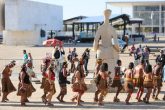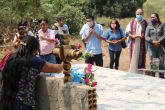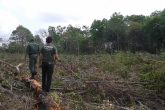Belo Monte: 12 questions without answers
By Dion Márcio C. Monteiro
Flowing deep in the Brazilian Amazon, the Xingu is one of the most important rivers of the region. Approximately 14 thousand indigenous people of Mato Grosso and Pará depend on it, and hundreds of communities composed of people who live on the river, fishermen, [legal reserve] extractivists, quilombolas [descendents of African slaves or marroons] and family farmers. They harvest their food from the waters of this river, and use it as a means of transport – not occasionally, but exclusively.
Prior to Dutch, English and Portuguese expeditions to the Xingu, which occurred mainly in the 17th century, the indigenous population was much larger, with villages that contained up to 3 thousand inhabitants. With the passage of time, the situation has only worsened for traditional and indigenous communities that exist in the region.
Military regime
In 1975, under the command of the military that had governed Brazil since the coup of 1964, Eletronorte (Centrais Elétricas do Norte do Brasil S.A.) initiated studies of the Hydrographic Inventory of the Xingu River Basin, the first step in the Belo Monte Hydroelectric Power Plant (HPP) construction project. The National Association of Consulting Engineers SA (CNEC Engineering), a company of the Camargo Correa Group at the time, one of those most interested in participating in the construction process of Belo Monte, was responsible for this survey.
Raoni and Sting
The year 1989 is a milestone in the process of resistance to the then-called Xingu Hydroelectric Complex (the proposal at the time called for a series of seven dams on the river). The first Meeting of Indigenous Peoples of the Xingu was held in Altamira, Pará. Approximately 3,000 people assembled, including indigenous leaders such as Raoni Metuktire (Kayapó chief), Marcos Terena and Ailton Krenak, and José Antonio Muniz Lopes, the then director of Eletronorte (who became president of Eletronorte under president Henrique Cardoso and now presides over Eletrobras); Also present: the British singer Sting, and hundreds of environmentalists and journalists.
Withdrawal
The enormous indignation of the indigenous and other peoples of the forest and its intense international repercussions, forced the government to withdraw, change strategy and revise their project. The point in those days was, however, to lead businessmen and influential politicians to desist from their original intentions.
Sixteen years later, in August 2005, Eletrobrás signed a cooperation agreement with the construction companies Norberto Odebrecht, Andrade Gutierrez and Camargo Correa for the completion of Technical, Economic and Environmental Feasibility Studies of UHE Belo Monte. In May 2009 the Environmental Impact Assessment (EIA) and Environmental Impact Report (RIMA) were delivered to the Brazilian Institute of Environment and Renewable Natural Resources (IBAMA), the Brazilian agency responsible for analysis of these documents and subsequent issuance of licenses for the auction and hydroelectric works.
In February 2010, the Brazilian government issued the so-called Licençia Prévia (LP- Preliminary License), authorizing the auction of the Belo Monte. In addition to the contractors already mentioned, it had the support of the French group GDF Suez; of important electro-intensive and mining groups, such as Votorantim, Vale and Alcoa, several businessmen, governors, mayors and parliamentarians.
Belo Monstro
But why do the Xingu peoples fight for more than twenty years against the construction of this dam – dubbed "Belo Monster" by residents of the region? The answer appears to be clear to those who know the forest and the river, but apparently "incomprehensible" to those who live thousands of miles away in south-central Brazil.
The independent panel of specialists
The EIA/RIMA for Belo Monte was prepared by Leme Engenharia, affiliated with Tractebel Engineering Group, in turn linked to the group GDF Suez, one of the possible participants in the auction for the construction of hydroelectric Belo Monte. In October 2009, five months after the final document had been delivered to IBAMA, there arrived at the same agency, and at the Ministério Público Federal (MPF- Federal Public Prosecutor), an alternative report of 230 pages, entitled "Critical Analysis of the Environmental Impact Study of utilization of the Belo Monte Hydroelectric". Over forty researchers contributed to its elaboration. Anthropologists , sociologists, zoologists, biologists, etymologists, PhDs in energy and energy systems planning, historians, political scientists, economists, engineers, hydrologists, ichthyologists, among others, composing a group called the Expert Panel. Affiliated with universities and national and international research centers, they engaged in a detailed study of the Belo Monte.
Generation average will be much less than announced.
The reservoir will displace 20 thousand families and the cost of the work,
financed by BNDES, may reach R$ 30 billion
Their report led to various inquiries, still unanswered, in addition to incorrect or inconsistent approach taken concerning a variety of controversial subjects in the Environmental Impact Study prepared by the company contracted by Eletrobrás. The report assembles a substantial quantity of provocative data.
1) The first factor to call attention – and one of those least highlighted by the federal government – is the planned allocation of energy to be generated by the Belo Monte Hydroelectric Plant. Approximately 80% of the electricity will go to industry in the Central South of the country. Up to 20%, if negotiations between the Federal Government and the government of Pará materialize, will meet energy-intensive enterprises of this state, in particular Vale and Alcoa. It will generate competitive advantages for these groups in the international arena, but will not provide 1 kilowatt (kW) for Amazonian communities that still lack electricity.
2) Also not disclosed is that the promised energy (approximately 11 thousand megawatt (MW), will only be delivered during four months each year. For another four months the plant will operate at only 30% to 40% of maximum capacity, the four remaining months, generating virtually no energy. The annual average will be around 4.5 thousand MW, according to data from Eletrobrás itself – extremely low in cost-benefit analysis and could even financially derail the project.
3) The Eletrobrás study delivered to IBAMA does not address the more than 20 thousand people to be compulsorily dislocated from areas where they live, leaving behind their social and economic relations, and material elements of their memories. Noteworthy is that the EIS uses as parameter the mean Brazilian count of members per household: between three and four. In the Amazon region, however, there is another mean [standard]. The available literature indicates that the family group is composed, on average, of 5.5 to 7 people. The consequences of this mistake are serious because in underestimating the population to be resettled, it is not possible to correctly project social structures and equipment necessary to meet housing needs, schools, health centers, roads and other public services. Similar problems have already manifested in the construction of the hydroelectrics of Tucuruí in Pará, the Balbina dam in Amazônia and the Samuel hydroelectric in Rondônia.
4) The Belo Monte EIS states that the reservoir, with 516 km2, will directly affect three municipalities: Altamira, Vitória do Xingu and Brasil Novo. However, specialists state that the lake will also affect Anapu and Senador José Porfirio. The official study cites 11 municipalities for socio-economic and environmental impacts from the hydroelectric: Altamira, Senador Jose Porfirio, Anapu, Vitória do Xingu, Pacajá, Placas, Porto de Moz, Uruará, Brasil Novo, Gurupá and Medicilândia, bringing the number to over 300 thousand inhabitants. Based on this information, the MPF has presented one of the objections to the licensing process. If the EIS itself reports that eleven municipalities will suffer impacts, prosecutors of the Ministério Público then contend that the four public hearings held in Belém, Altamira, Brasil Novo and Vitória do Xingu are not sufficient. They lacked participation, ample debate and the clarifications for the affected population, the very reasons for holding the hearings.
5) The Energy Research Company (EPE- Empresa de Pesquisa Energética), under the Ministry of Mines and Energy (MME), stated in October of 2009, that the cost of Belo Monte would be R$16 billion. Five months later, and one month after issuing the Preliminary License, the EPE reassessed this cost upward to circa R$ 20 billion. The contractors, major stakeholders in the construction of the plant, estimate that the final figure will not be less than R$ 30 billion. This uncertainty about the total cost of the project precludes a reliable assessment regarding cost effectiveness and economic viability. It is important to stress those costs not considered: power transmission networks, substations, and other structures necessary for full operation of the hydroelectric complex. In March 2010, the EPE also raised the price cap by more than 20% (from R$68 to R$83/kwh), for energy sold at the Belo Monte auctions.
6) The developers estimate that approximately 100 thousand people will migrate to the region, especially towards the city of Altamira. Some specialists say that this number, like others stated by the government, is also underestimated. Calculating according to past figures generated by similar projects, a minimum is indicated of 150 thousand people. Eletrobrás notes in the EIA/RIMA that directly associated jobs would be generated at the height of the project, numbering 18 thousand, in the third and fourth years of construction. Added to 23 thousand indirectly employed would be 41 thousand jobs. In the government’s own accounts, therefore, approximately 60 thousand people migrating into the region would not, at any time, have employment. The project would last ten years. At the end of construction, the employment numbers are 700 direct and 2,700 indirect jobs. The EIA estimates that 32 thousand migrants would remain in the region after completion of the project, mostly in Altamira.
Indigenous peoples were not adequately heard.
Greenhouse gas emissions could be underestimated.
Certain conditions set by IBAMA will only be checked
years after completion of the plant
7) According to the Intergovernmental Panel on Climate Change (IPCC), methane (CH4) is a greenhouse gas with 25 times the global warming impact of carbon dioxide per tonne emitted. Hydroelectric plants are responsible for methane emissions from decomposition of submerged vegetation with the creation of the reservoir (for Belo Monte, more than 500 km ²), releasing large quantities of the gas. CH4 production also occurs in the process of water passing through turbines and spillways of the dam, something completely ignored by the EIS. Large hydroelectrics in particular aggravate the situation, because the greater the area flooded and water moved, the greater the emission of methane.
8) The EIA/RIMA states that Belo Monte would directly impact the Paquiçamba Indigenous Lands (the Juruna people), Arara and the Volta Grande do Xingu (Arara people) in addition to Indigenous Area Juruna of KM 17 (also the Juruna people). The Indigenous Missionary Council (CIMI) states that also directly affected would be Indigenous Land Trincheira Bacajá (Kayapó and Xicrin people). Although recognizing this direct impact, the government refuses to conduct the indigenous hearings, as required by Article 231 of the Federal Constitution and Convention 169 of the International Labour Organisation (ILO), of which Brazil is a signatory. This also is one of the primary questions raised by federal prosecutors (MPF).
9) With the construction of the dam’s main plant of Belo Monte, an area of approximately 100km, the so-called Volta Grande do Xingu, will have its water flow reduced to circa 30% of current volume. In this regard, Technical Opinion No. 114/2009, signed by six environmental analysts of IBAMA, and one of the basic documents used for issuing the Preliminary License, is clear. The opinion states: "The study on the hydrograph of consensus does not provide complete information about the maintenance of biodiversity, navigability and the living conditions of the populations of the Stretch of Reduced Flow [TVR – Trecho de Vazão Reduzida]”.
10) In order for the waters of the Xingu to flow to the dam housing the 20 turbines planned for Belo Monte, two giant channels will be opened in the forest. These will displace approximately 150 million cubic meters of earth and 60 million cubic meters of rock, equivalent to the material displaced in the opening of the Panama Canal. The impacts were not fully accounted for in the Belo Monte EIA/RIMA, besides which, clear information was not provided about the final destination of material removed if the project goes forward.
11) Technical report No. 114/2009 also states that, "in view of the deadline stipulated by the President [of IBAMA], this team has not properly concluded its analysis. Some issues could not be analyzed in appropriate depth, among them the indigenous issues and the contributions of the public hearings”. The environmental analysts stress however that they did identify environmental issues relating to the TVR and the failure to properly scale the impacts of population influx to the region. As a consequence, measures attempting to prepare the region to receive such an influx may be insufficient, in addition to which responsibilities of respective public agencies is left undefined with regard to the necessary actions. A third element presented in opinion 114/2009 is an elevated degree of uncertainty about the prognosis of water quality, particularly in the reservoir from the canals of the hydroelectric.
12) The Preliminary License No. 342/2010, issued by IBAMA on February 1, 2010, presented 40 conditions for carrying out the project. Compliance with several of them, however, can only be certified after completion and full functionality of the project. This applies to the guarantee of water quality, navigation and way of life of the populations of the Volta Grande of the Xingu. The license also neglects the presentation of strategies for ensuring the infrastructure that precedes the work. These strategies will be set only after the selection of the company that will generate the energy. The indefinite nature is being questioned by various social movements, NGOs and the Public Prosecutor (MPF). It is understood that it is not possible to delay the fulfillment of these conditions. After conducting the auction, the political and economic pressure on the winning consortium for a rapid project start will be much greater. There will be a huge risk of marginalization of debate about important factors for the preservation of life and the Xingu river itself.
Alternatives:
recourse to clean sources
discuss a new paradigm of production and consumption
re-examine relations between human beings and nature
These twelve points, raised through examination of the EIA/RIMA and the report from the Panel of Specialists, do not exhaust the existing issues. One of these is the imminent danger of reverting to the original design for the construction of hydroelectrics on the Xingu River. Originally calling for seven dams, the number was later reduced to five. The indefinite elements that exist around Belo Monte render economic viability uncertain, which could trigger the temptation to "complete it". The volume of energy delivered by the plant will be equivalent to approximately 39% of its maximum generation capacity – while the technical recommendation is at least 55%. Nothing impedes the government from, in the future, proposing to "optimize" the enterprise by constructing new dams on the Xingu.
It is also interesting to verify the involvement of the Banco Nacional de Desenvolvimento Economico e Social (BNDES). For financing up to 80% of Belo Monte, the institution will need to capitalize, especially after the EPE reevaluated the cost of the work at R$ 20 billion. The bank is also financing the project for up to 30 years, five of which are grace period and 25 years in amortization. At present, the BNDES board of directors allows financing for only 25 years, 20 of which are amortization. Interest rates on the loan to the winning consortium will be the lowest in the market. It is worth noting that a major funding resource of BNDES is the Workers Support Fund (FAT), a special fund designated for unemployment insurance, salary bonuses and funding economic development of working men and women in Brazil.
Belo Monte is one of the largest investments in the Program for Acceleration of Growth (PAC) of the federal government. As such, it has received special attention. This was particularly clear in February 2010. The Attorney General (AGU- Advocacia-Geral da União) threatened to sue members of the MPF who oppose the licensing and construction of the plant, claiming that the suits filed by them are "baseless, designed solely to disrupt the achievement of public policies relevant to the country".
Diverse indigenous communities have long made clear their opposition to the construction of Belo Monte. One of the messages was expressed in a letter sent on 1 November 2009, to president Lula, by the indigenous peoples Mebengôkre (Kayapó), Xavante, Yudjá (Juruna) Kawaiwet (Kaiabi) Kisêdjê (Suiá) Kamaiurá, Kuikuro, Ikpeng, Panará, Nafukua, Tapayuna, Yawalapiti, Waura, Mehinaku and Trumai, inhabitants of the Xingu River basin and surrounding regions. Gathered in the village Piaraçu (Indigenous Land Capoto / Jarina), stated verbatim: "In the event that the government decides to initiate the construction of Belo Monte, we warn that there will be a warrior action by the indigenous peoples of Xingu. The lives of workers and indigenous people is at risk and the Brazilian government will be held responsible”.
The development model implemented in the Amazon region has historically been guided into large vegetal, mineral, and water exploitation projects. This can be verified in the hydroelectric projects Tucuruý, Pará; Curuá-Una also in Pará; Balbina, in Amazonia; Samuel in Rondônia, in gold exploitation projects in Serra Pelada, in the municipality of Curionópolis, conducted by a prospecting cooperative, the exploitation of iron in Parauapebas carried out by Vale; the exploitation of bauxite in Juruti, conducted by Alcoa; nickel exploitation in Ourilândia do Norte, by Vale; exploitation of bauxite in Oriximiná by Mineração Rio do Norte/Vale, Copper exploitation in the Canaã dos Carajás, by Vale; and exploitation of bauxite in Paragominas, again by Vale. All of the projects cited are located in the state of Pará.
Initiation of the exploitation of natural resources in the Amazon dates from the late16th century. It was always an authoritarian process, which has extended into the "modern" era, since the late 1930s. The process has demonstrated the unsustainability of the current development model and especially the urgent need for alternatives. They include a menu of transformations. The energy can be generated from renewable clean sources: solar, wind, biomass waste of non-monoculture origin. The development paradigm is perfectly capable of establishing harmony between nature and humans, first ensuring the existence of the planet. The insistence on the current standard will amplify climatic and environmental disasters, already at an advanced stage.
Dion Márcio C. Monteiro is an economist at the Amazon Solidarity and Sustainability Institute (IAMAS), a doctoral candidate in sociology at the Université Paris-Nord (France), and member of the Metropolitan Committee of the Movemento Xingu Vivo para Sempre






